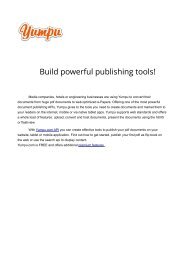test_pdf.pdf
You also want an ePaper? Increase the reach of your titles
YUMPU automatically turns print PDFs into web optimized ePapers that Google loves.
ADDRESSING<br />
FUTURE<br />
ARMS<br />
CONTROL<br />
AND SECURITY<br />
PROBLEMS<br />
Verification is one area that I’m concerned about. But the pendulum—as I looked at verification in the 1980’s<br />
and 1990’s, which was an onerous task, an onerous chore with lots of stupid rules—has swung completely to the<br />
other side, where there are no rules. And that needs to be looked at, but we have time to do that.<br />
And I’ll also tell you that one of the things that I’m most disappointed in both sides of the aisle is the fact that<br />
we have not stepped up to the control of tactical nuclear weapons. If you talk to the folks at CIA, they will tell<br />
you—they probably won’t tell you —the range estimates for tactical nuclear weapons of the former Soviet Union<br />
and Russia range anywhere from 12,000 to 18,000. Tactical nuclear weapons. And no one has stepped up to<br />
account for the inventory of tactical nuclear weapons, both in Russia and the United States. That is unacceptable,<br />
in my view.<br />
Let’s talk a little bit about the role of nuclear weapons today and the strategy. Well, why do we have nuclear<br />
weapons today? Well, because the Cold War really didn’t end, and both the United States and Russia have<br />
relatively large numbers of nuclear weapons. They’re like two boxers ready to go after each other and neither of<br />
them wants to back away. Yet we’re coming down, postures are easing. We need to do some things, and I’ll talk a<br />
little bit about a RAND study here in a few minutes, to get away from the risk of accidental war with nuclear<br />
weapons. But because we started out at the end of the Cold War without disarming the Russians from a nuclear<br />
perspective, it’s going to take us a long, long time, 21 years, to get down to lower and lower levels of nuclear<br />
weapons.<br />
The nuclear weapons also serve as a deterrent against weapons of mass destruction. Not against transnational<br />
terrorist groups. You don’t deter them with inventories of nuclear weapons. But because you have nation states<br />
out there with chemical and biological weapons, and Richard talked about the ability to deliver these weapons<br />
with systems that I call asymmetrical—relatively cheap, relatively without fingerprints on them if you want to<br />
make them that way. That’s one of the reasons why we’re going to require nuclear weapons. At the levels we have<br />
now? No. But we’re going to require some.<br />
And obviously we live in an entirely different world, and that’s a simplistic statement. Things have changed,<br />
but we’re in what I call a target-rich environment. One nuclear device can kill several millions of people because<br />
people live in small areas. I’m sure the South Koreans are concerned of the fact that 40 percent, over 14 million of<br />
South Korea’s population, lives within 60 miles of the center of Seoul. That’s what I call a target-rich environment.<br />
Whether you’re talking about a nuclear device, nuclear weapon, or an anthrax attack.<br />
An excellent study by RAND is Beyond the Nuclear Shadow. It talks about how we can defuse the accidental<br />
war issue with Russia. The question was asked earlier about new weapons. I think that’s a terrible waste of<br />
money. To go out and spend upwards of $10 billion for a weapon which has very, very little military utility does<br />
not make a lot of sense. In 1997 I accepted on behalf of the Department of Defense the first weapon to reach deeply<br />
buried targets. It was called the B-61, model 11. It was a B-61 bomb put in a case steel hardened container. It would<br />
go several meters under earth. It would not be a rock-buster, but in my view that’s all we need. To go out and spend<br />
big bucks for a weapon that has very little utility doesn’t make much sense.<br />
I’d like to end on a positive note. I think we all ought to be pleased that in June of 2002 the G-8 global<br />
partnership pledged up to $20 billion over the next 10 years for nonproliferation, disarmament, counter-terrorism<br />
and nuclear safety. If I would offer you up one request, it would be continue pressuring our government, both on<br />
the executive side and legislative side, to keep the pressure up so we make that program work because it makes<br />
sense and it’s the right thing to do. Thanks very much.<br />
MS. KELLEHER: We have about 25 minutes for questions now. If you would please come to the microphone<br />
and identify yourself, and the member of the panel to whom you’d like to address the question. Daryl.<br />
Q: I’m Daryl Kimball. My question is for General Habiger. I wonder if you could clarify something you said<br />
which sounds somewhat contradictory. You argue that nuclear weapons are necessary to deter WMD, but you<br />
also say that new nuclear weapons—designed for deep bunkers or chem-bio targets—are unnecessary. Also,<br />
given your experience, can you describe any reasonable circumstance under which an American president might<br />
actually use a nuclear weapon?<br />
GEN. HABIGER: We are spending billions of dollars a year for something called a science-based stockpile<br />
stewardship. An outside commission looks at it every year. Department of Energy and Department of Defense<br />
look at it every year to make sure that our nuclear stockpile that we have on board today is safe, reliable, and<br />
functional. This is part of the overall strategy for getting away from nuclear <strong>test</strong>ing, which the current administration<br />
has walked away from.<br />
We have nuclear weapons that can do very low-yield. I spent most of my career as a junior officer, lieutenant,<br />
60<br />
60
















